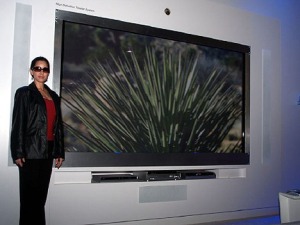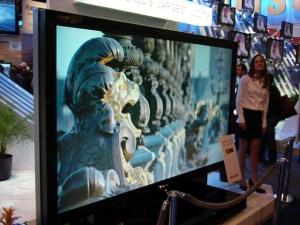If you are like many consumers who are in the market for a new television, you’ve probably dreamed about making it a plasma or LCD flat screen HDTV.
May be you spent some time looking over the Sunday circulars from Best Buy, Circuit City, and other major retailers. Perhaps you spent some time on the internet, shopping around for the bets price. You may even have read a few product reviews here and there.
It’s also probable that, like your fellow shoppers, you aren’t quite sure exactly what the difference is between LCD and plasma. Sure, they’re both flat. One seems to be brighter than the other, but a little washed out at times. Some are marked HDTV, you might know what that means, but what does “EDTV” mean?
Is your new flat-screen TV going to “burn-in”, “burn-out”, or “burn-up”? Just how long will it last before you have to replace it? Does the gas leak out of a plasma TV? Will sunlight hurt your LCD TV?
And just who are all of these companies selling LCD and plasma TVs? Sure, you’re heard of Sony and Samsung, Panasonic and Philips, Polaroid and Toshiba. But who the heck is Maxent? Funai? Ovideon? Syntax? Vizio?
For us journalists, covering the fast-growing market for plasma and LCD TVs can be a real challenge at times. For consumers, it can be frustrating, confusing, intimidating, and expensive. There are an awful lot of products to choose from, but they’re not all “created equally”. Nor do they offer the same resolution and connector options.
In the interest of clearing up some of this confusion, I’ve prepared a list of things you should know about plasma and LCD TV technology, and some shopping tops to take along when you are searching for the ‘perfect’ flat screen TV. You know the old saying – ‘forewarned is forearmed!’
The Facts on Plasma
Both plasma tv and LCD technology are ‘mainstream’. Numerous companies sell these TVs in a variety of sizes, and prices are dropping faster than an elevator with a broken lift cable. Because of increasing consumer demand (and the fact that the United States is the #2 market worldwide for TVs), plenty of companies have gotten into the game.
Here’s something you should know. In the plasma market, there are only a handful of companies that actually manufacture plasma TVs. Not surprisingly, these companies typically have the best image quality and the broadest line of products available.
In Japan, Panasonic, Pioneer, and Hitachi are the ‘Big Three’ in the plasma manufacturing. Panasonic is rolling out about 100,000 panels a month in 37-inch EDTV, 42-inch EDTV, 42-inch HDTV, and 50-inch HDTV sizes. They also have a new 65-inch model coming to market. Pioneer manufactures 43-inch HDTV and 50-inch HDTV plasma TVs using their original assembly line, and 42-inch, 50-inch, and 61-inch products on the ex-NEC line they purchased in January of 2004.
Hitachi also cranks out various sizes of plasma in the FHP factory that was originally a joint venture with Fujitsu. (Fujitsu recently announced they were withdrawing from the plasma manufacturing business). Hitachi panels sold in the United States include 37-inch and 42-inch HD ALiS (Alternate Lighting of Surfaces) designs, and a unique 55-inch HD plasma TV.
In Korea, Samsung SDI is the clear leader with about 250,000 panels a month flying off their assembly line. Samsung manufactures 42-inch EDTV, 42-inch HDTV, 50-inch HDTV, and 63-inch HDTV plasma TVs for the mainstream market. (An 80-inch model is also set to debut recently). Neighbor LG Electronics is active with 42-inch, 50-inch, 60-inch, and even 71-inch products.
In China (Taiwan), Chunghwa Picture Tube (CPT) is rolling out 46-inch EDTV and HDTV plasmas, based on older Mitsubishi designs. Aside from the odd startup here and there, your plasma TV will use ‘glass’ from one of these six manufacturers, even if it has a different name on the front plate.
Certain sizes of plasma TV screens are as unique to a company as a fingerprint, such as 43-inch (Pioneer only), 55 inches (Hitachi only), 61 inches (Pioneer only) and 63 inches (Samsung only). If you see one of these with another brand name on it and a higher price, you may simply be paying a premium for that brand, or there may actually be some added value, such as improved video processing and sealing.
Keep in mind that true HDTV resolution can’t be found in plasma TVs smaller than 50 inches. There are two HDTV broadcast standards – 1920×1080 interlaced (1080i), and 1280×720 progressive (720p). So, in order for a plasma TV to be considered truly ‘HD’, it should have at least the same amount of pixels as a 720p signal, or more.
‘HD’ in smaller sizes of plasma means that there are more pixels than ‘ED’ plasma, but generally not as many as there are in a true HD display. So, you’ll find that it’s difficult to see any substantial difference in picture quality between these two types of plasma TVs, particularly when viewing an HDTV program.
The Facts – LCD Television
There are a number of companies manufacturing both the LCD panels used in these TVs and the finished TVs themselves. In Japan, the clear market leader is Sharp tv Electronics, who offers a wide range of sizes from under 20 inches to 26-inch, 32-inch, 37-inch, and even 45-inch LCD TVs. In Korea, Samsung SDI and LG Philips produce large quantities of LCD panels in sizes as large as 55 inches, and Samsung, LG, and Philips all retail them as finished TVs.
In Japan, Hitachi, NEC, Kyocera, Sanyo, and Panasonic have all manufactured smaller LCD TV screens at one time or another. In China, a host of companies are cranking out LCD TV products including Chi Mei Optoelectronics, AUO, and Chunghwa Picture Tube in sizes to 46 inches.
Your Television is going to come from one of these companies, but it’s a little harder to tell exactly which one than it is with plasma. The LCD market goes through cycles of panel oversupply and undersupply quite frequently, and trading companies who wholesale to US retailers constantly shop around to get the best price for their latest models.
As with plasma, the companies who make the largest quantities of LCD TVs (Sharp, Samsung, and LG with partner Philips) typically have the best picture quality. You’ll also see higher prices for these brands than you will with the dozens of “who’s that?” brands out there.
That doesn’t mean the “who’s that” brands are to be avoided. A new player in the market, Kreisen, recently announced 37-inch and 40-inch LCD TVs with analog tuners that use LG and Samsung LCD panels, but at greatly discounted prices from those brands. (Kinda like buying a generic version of a drug at Walgreens).
Unlike plasma TVs, all widescreen LCD TVs over 15 inches in size have true HD resolution (usually 1280×768 pixels, sometimes more). Bigger models starting at 46 inches and up actually have 1920×1080 pixel resolution, but they command quite a price premium at the moment.
LCD TVs don’t suffer from ‘burn-in’ or ‘burn-out’ like plasma panels do. They can, however, have ‘stuck’ or dead pixels. The leading manufacturers have higher standards for defective pixels, so you can usually purchase from those companies with confidence that you won’t see white, black, red, green, or blue dots on your TV programs that won’t go away (and if you do, your warranty offers some protection).
Continue reading here.



No comments:
Post a Comment